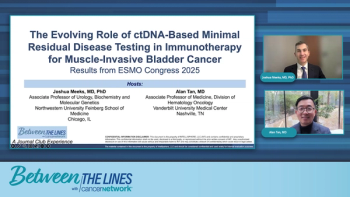
Key Results From the COCOON Study for EGFRm NSCLC Patients
Panelists discuss how the COCOON study demonstrated a significant reduction in grade 2 or higher dermatologic adverse events from 73% to 41%, with particularly notable improvements in face, body, and scalp rashes while maintaining comparable response rates.
Episodes in this series

The COCOON study demonstrated significant clinical benefits in its primary end point, showing a substantial reduction in grade 2 or higher dermatologic adverse events within the first 12 weeks of treatment. The intervention arm achieved a 41% incidence rate compared to 73% in the standard care arm, representing a clinically meaningful 32 percentage point improvement. This reduction translated to 43 out of 70 patients in the COCOON regimen avoiding grade 2 or higher dermatologic adverse events by week 12, vs only 16 of 68 patients in standard care.
Specific anatomic site analysis revealed impressive improvements across multiple areas: face and body rashes decreased from 59% to 26%scalp adverse events reduced from 26% to 10%, while paronychia showed modest improvement, from 21% to 20%. The intervention maintained comparable objective response rates between arms, confirming that prophylactic dermatologic management did not compromise anticancer efficacy. Treatment discontinuation rates were lower in the COCOON arm (16% versus 20%), suggesting better overall tolerability with proactive management.
The clinical significance of reducing grade 2 or higher dermatologic adverse events from 73% to 41% represents a major advancement in supportive care for patients receiving EGFR-targeted therapy. Grade 2 adverse events significantly impact quality of life and daily functioning, making this reduction particularly meaningful for patients on chronic oral therapy regimens. The tolerability profile of the COCOON regimen itself proved acceptable, with only 2 participants discontinuing antibiotics due to adverse events, supporting the feasibility of implementing this comprehensive prophylactic approach in routine clinical practice.
Newsletter
Stay up to date on recent advances in the multidisciplinary approach to cancer.




















































































